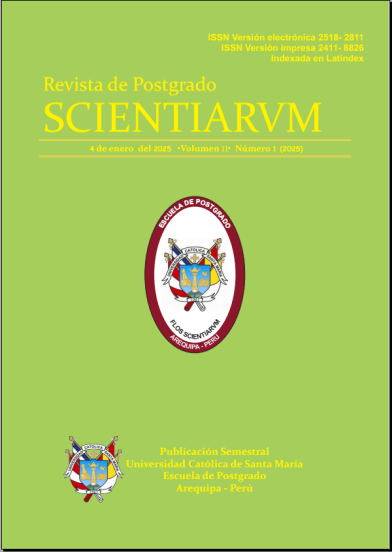ACTIVIDAD ANTIBACTERIANA IN VITRO DEL EXTRACTO ALCOHÓLICO DE CURCUMA LONGA LINN AL 4, 8, 12 Y 16% SOBRE FLORA SALIVAL MIXTA
ANTIBACTERIAL ACTIVITY IN VITRO OF THE ALCOHOLIC EXTRACT OF CURCUMA LONGA LINN AT 4, 8, 12 AND 16% AGAINST MIXED SALIVARY FLORA
Diana Bravo Oviedo1, Mónica Salas Rojas1, María del Socorro Barriga Flores1
(1) Universidad Católica de Santa María, Arequipa - Perú
RESUMEN: El propósito de este estudio fue demostrar la actividad antibacteriana del extracto alcohólico de la Curcuma Longa Linn frente a los microorganismos presentes en la flora salival.
La investigación tuvo como muestra la flora salival de estudiantes del X Semestre de la Facultad de Odontología de la Universidad Católica de Santa María. El método utilizado para su tratamiento fue Kirby Bauer, con discos de inhibición del extracto alcohólico de cúrcuma, en concentraciones de: 4%, 8%, 12% y 16%. Se utilizaron como control positivo clorhexidina al 2% y control negativo solución salina al 0.09% (suero fisiológico).
Se obtuvieron resultados de los promedios de las medidas de halos de inhibición para el extracto alcohólico de cúrcuma: al 4% 7.588mm, al 8% 7.763mm, al 12% 8.163mm y al 16% 8.463mm, para el control negativo de solución salina al 0.09%: 6mm, y el control positivo de clorhexidina al 2%: 18.475mm.
Estadísticamente se encontró diferencia significativa (P<0.05). entre las diferentes concentraciones del extracto alcohólico de Curcuma longa Linn, de mayor halo obtenido en la concentración al 16%, seguida del 12%. Las otras concentraciones no tuvieron mayor relevancia.
De este modo se concluye que el extracto alcohólico de Curcuma Longa Linn no posee actividad antibacteriana frente a los microorganismos de la flora salival mixta.
Palabras clave: Cúrcuma longa, flora salival, halo de inhibición, sensibilidad, actividad antibacteriana.
ABSTRACT: The purpose of this study was to demostrate the antibacterial activity of the alcoholic extract of Curcuma Longa Linn against the pathogen microorganisms at the salivary flora.
The investigation had as sample the salivary flora of the students of X semester of Dentistry of the Catholic University of Santa María- the method used for its treatment was Kirby Bauer, with discs of inhibition of the curcuma alcoholic extract at concentrations of 4%, 8%, 12% and 16%.The positive control was clorhexidine at 2% and negative control was saline solution at 0.09% (physiological serum).
The results obtained were averages of measures of inhibition halos for the curcuma alcoholic extract: at 4% 7.588mm, at 8% 7.763mm, at 12% 8.163mm, and at 16% 8.463mm, for the negative control of saline solution at 0.09%: 6mm, and the positive control with chlorhexidine at 2%: 18.475mm.
Statistically it was found significative difference (P<0.05) between the different concentrations of the alcoholic extract of Curcuma longa Linn, with the highest halo obtained with the 16% concentration, followed by 12%. The other concentrations had no greater relevance.
In this way, it concludes that the alcoholic extract of Curcuma longa Linn doesn´t have antibacterial activity against microorganisms of the mixed salivary flora.
Key words: cúrcuma longa, salivary flora, inhibition halo, sensibility, antibacterial activity
Revista Seleccionada
Julio 2019 Volumen 5 - Número 2 P 27-29
DOI: 10.26696/sci.epg.0102
Enlaces
EDITORIAL
CIENCIAS SOCIALES Y HUMANIDADES
EL ANÁLISIS ECONÓMICO DEL DERECHO
EL IMPACTO DE LA MINERÍA EN LA ECONOMÍA DEL DEPARTAMENTO DE AREQUIPA
CIENCIAS BIOLÓGICAS Y DE SALUD


